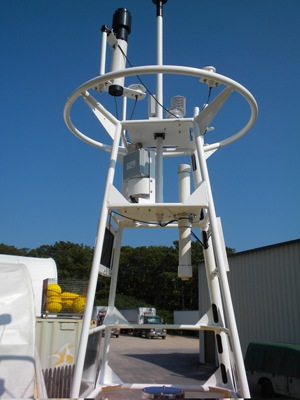WHOI and Ocean Leadership Select Pro-Oceanus Systems to Provide OOI Instrument Packages
2011/10/18

The p(CO2) air-sea instrument package will measure CO2 in the surface water and in the air just above the water to get a better picture of how CO2 moves between the atmosphere and the ocean. This is very important when looking at the impacts of increases of atmospheric CO2 on the ocean.
(Photo courtesy RD Sea and Associates)
FOR IMMEDIATE RELEASE
October 18, 2011
(508) 289-3340
Media Relations Office
media@whoi.edu
The Woods Hole Oceanographic Institution (WHOI) and the Consortium for Ocean Leadership (OL) awarded a contract to Pro-Oceanus Systems, Inc., of Bridgewater, Nova Scotia, Canada, to provide Partial Pressure of CO2, or p(CO2) , air-sea instrument packages for the Coastal and Global Scale Nodes (CGSN) component of the Ocean Observatories Initiative (OOI) program.
WHOI, as implementing organization for the CGSN component of the OOI, awarded the contract for the p(CO2) air-sea instrument packages that will be mounted on surface buoys which will be deployed in both coastal regions (depths up to 500 m) and open ocean regions (at latitudes above 40 degrees).
The estimate quantity under the contract is for 28 of the packages. The term of this contract is for a three-year base period with one one-year option. The minimum contract value is $28,732 and the maximum estimated contract value of all orders issued under this contract is $800,000.
The p(CO2) air-sea instrument package will measure CO2 in the surface water and in the air just above the water to get a better picture of how CO2 moves between the atmosphere and the ocean. This is very important when looking at the impacts of increases of atmospheric CO2 on the ocean.
“These CO2 samplers are an important component of the instrument payload on the surface moorings to be deployed at the OOI coastal and global sites,” said Bob Weller, WHOI Principal Investigator for the OOI CGSN. “While such CO2 measurements have been used extensively for terrestrial study, the adaptation of sampling methods for ocean research is relatively a new concept; and their deployment allows OOI to contribute to extremely important investigations of the pathways of carbon between the atmosphere, ocean, and land and of the impacts of additional CO2 on the ocean.”
The OOI’s design includes four strategic high-latitude sites to implement global scale nodes to collect data in the Southern Ocean, southwest of Chile; Irminger Sea, southeast of Greenland; Argentine Basin, in the South Atlantic; and Station Papa in the North Pacific. The OOI’s coastal scale nodes are designed to provide sustained, but adaptable, access to complex coastal systems. The coastal observatory consists of the Endurance Array off the coast of Oregon and Washington and the Pioneer Array off the coast of New England.
The OOI, a project funded by the National Science Foundation (NSF), is planned as a networked infrastructure of science-driven sensor systems to measure the physical, chemical, geological and biological variables in the ocean and seafloor. As a fully integrated system, OOI will collect and disseminate data on coastal, regional and global scales. Through a unique cyberinfrastructure, OOI will make ocean observing data available to anyone with an internet connection. Greater knowledge of the ocean’s interrelated systems is vital for increased understanding of their effects on biodiversity, climate change, ocean and coastal ecosystems, environmental health and climate.
WHOI and its partners, Oregon State University and Scripps Institution of Oceanography are responsible for the OOI coastal and global arrays and their autonomous vehicles.
The OOI Program is managed and coordinated by the OOI Project Office at the Consortium for Ocean Leadership in Washington, D.C., and is responsible for construction and initial operations of the OOI network. Four Implementing Organizations are responsible for construction and development of the overall program. In addition to WHOI, the University of Washington is responsible for cabled seafloor systems and moorings. The University of California, San Diego, is implementing the cyberinfrastructure component. Rutgers, the State University of New Jersey, is responsible for the education and public engagement software infrastructure.
About the Consortium for Ocean Leadership
The Consortium for Ocean Leadership is a Washington, D.C.-based nonprofit organization that represents 99 of the leading public and private ocean research and education institutions, aquaria and industry with the mission to advance research, education and sound ocean policy. The organization also manages ocean research and education programs in areas of scientific ocean drilling, ocean observing, ocean exploration, and ocean partnerships.
For more information on the OOI please visit the OOI Website or follow us on Facebook.